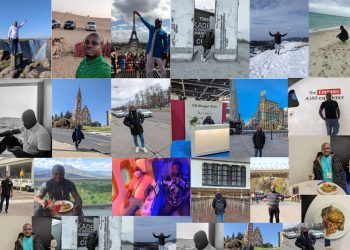Fuller Falls, located in the Bono East region of Ghana is one of the best tourist sites to visit in Ghana, not because of the amazing and unique flow of the water but largely because it provides you the opportunity to visit so many other attractions all located within the area.
There are several other tourists sites such as Kintampo Falls and Tano Boase Caves near Fuller Falls which tourists can take a few minutes ride to and experience their beauty.
Kintampo Falls
The Kintampo Waterfalls needs no introduction especially if you are a Ghanaians. The waterfall is one of the highest in Ghana and is located on the ever-popular Pumpum River. The waterfall lies deep within a dense rainforest which measures about 4km from the main Kintampo Township and tourists would have to walk for an about 15minutes to get to the actual waterfall. It is arguably the most popular attraction in the entire Bono East region and receives the highest number of tourists annually with the number running into almost a million visitors every year.
Tano Boase Caves
The Tano Boase Caves is situated within the Tano Sacred Grove, in a small forest section of the grove. There one can find these uniquely impressive sandstorm rocks which have large spaces between them with other rocks serving as roof and covering the top, large enough to contain dozens of people or serve as a home for small groups of people. According to the history of the indigenes, the rocks served as home to the first humans who settled there more than 500years ago but later the people moved out and built for themselves mud houses as civilization drew closer. The caves however still played an important role as they used it as a watchtower to view enemy attacks from afar. It is a nice place to visit and learn some historical fact and lies just some 5km away from Fuller Falls.
Boabeng-Fiema Monkey Sanctuary
Boabeng-fiema Monkey Sanctuary is another major attraction near Fuller Falls located in the twin town of Boabeng and Fiema in the Nkoranza North District of the Bono region. The sanctuary is one of the most popular and visited wildlife tourism destinations in the region. It was created in the early part of the 1970s and covers a total land area of about 4.5 km2, with about 650 monkeys of different species living in the forest. The sanctuary even though is mentioned as being in the town of Boabeng-Fiema, is actually a few metres away from the town, lying just at the outskirt of the two twin communities. Inhabitants of the community take responsibility for the welfare of the monkeys wholeheartedly and regularly provide them with foods such as banana and other edible fruits. Aside monkeys, Boabeng-Fiema monkey sanctuary is also quite famous for its variety of tree species, Deer, reptiles and birds.
While the sanctuary boasts of several species of monkeys, the most dominant species in the forest are the Mona and Pied Colobus monkeys, accounting for more than eighty percent of the monkey population. The tradition of the community which prevents human from hunting or killing the monkeys has helped preserved the monkeys for decades, making the community the safest place of abode for the monkeys as their survival is guaranteed through the community’s customs. When a monkey dies either through accident or a natural cause, it is given a special burial by the chief priest of the town as the people believe the monkeys are sacred animals in whom friendly spirits reside
Bui National Park
Bui National Park is a must-visit attraction near Fuller Falls. The park was established in 1971 to serve as a major eco-tourism attraction in the Ahafo region. With a land size of 1820 square kilometre, the park is the third-largest national park in the country and is also known to have some of the best wildlife varieties for any reserve in Ghana. Its animal population includes the Hippopotamus which are mostly found in the Black Volta that run through the park, the very rare and endangered Colobus monkeys and different species of birds and antelopes. The facility is opened to the entire public for touring purposes. There are also small boats at the park for taking a safari ride on the Black Volta where you will come into close contact with the gigantic hippopotamuses.
Digya National Park
The Digya National Park is the oldest national park in Ghana, created in the early 1900s by the British colonial administrators of the then Gold Coast. Also, the park is the second-largest protected wildlife park in the country with area coverage of some 3,750 km. The park which is very close to the Fuller Falls was officially gazetted as a national wildlife park in 1971, even though it had been existence for over six decades. Prior to this, there were human settlements on the park, engaged in livelihood activities like farming. Governments over the decades made attempts to relocate the park settlers. This was finally achieved in 2006 under the presidency of John Agyekum Kufour when all the settlers were relocated, making Digya National park an animal-only inhabited park. In terms of wildlife population, the park is home to several animals, especially rare primate species, antelopes and different species of Elephants. The park is also home to over 200 species of birds as well as butterflies.
Digya National Park uniquely is the only wildlife park in Ghana that is bordered by the Volta Lake on three fronts; south, north and east, making it one of the most safest and rich animal parks in Ghana. The park is one of the most visited in Ghana, receiving huge number of tourists annually, especially animal lovers who throng the park to see for themselves some of these rare animals who are seen once in a lifetime. The Park is also known to have the second-highest elephant population in Ghana, making it a prime destination for everyone hoping to catch a glimpse of the tall humble beast. In recent years, the government has had to institute measures to fight illegal activities like elephant poaching in the forest. This resulted in the establishment of a patrol team to guard the park and ensure the arrest of people who engage in the practice while also protecting the animals in the forest.
Still have some travel questions? Ask in our Travel WhatsApp Group.







